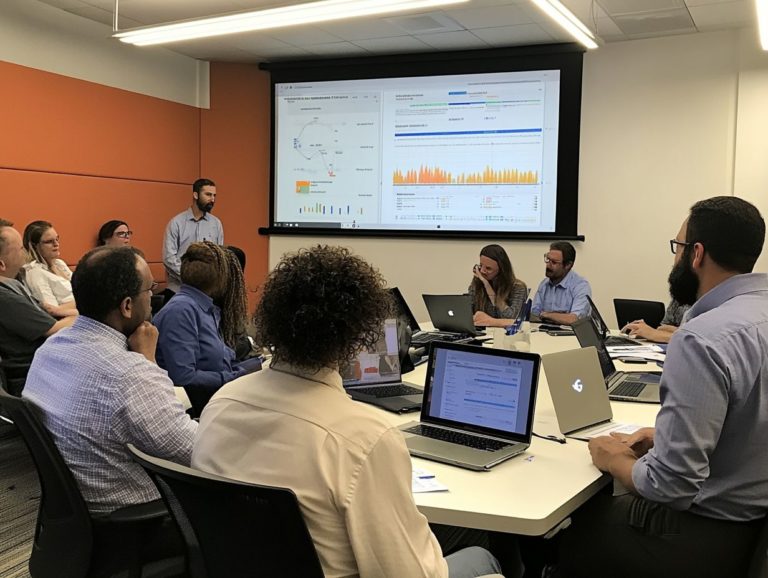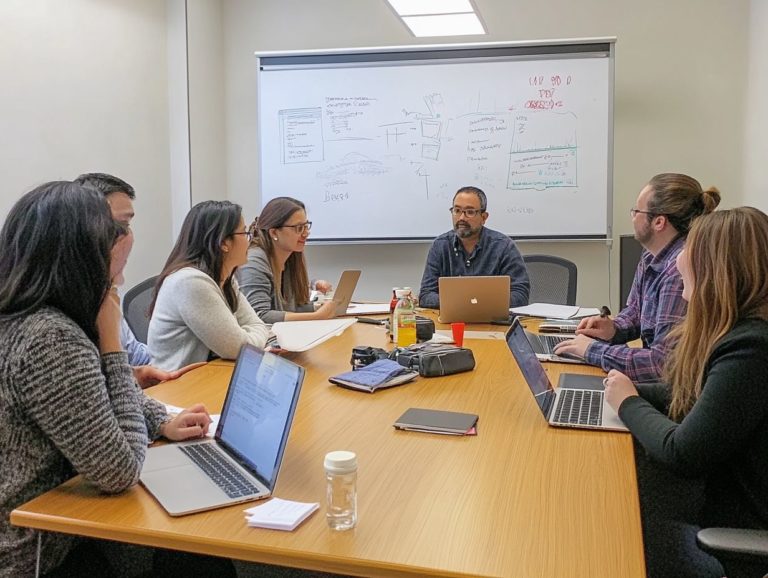how to leverage vulnerability assessments for compliance
In today’s fast-paced digital landscape, grasping the nuances of vulnerability assessments is vital for your organization’s success! These checks find weaknesses in your security, helping you protect your assets and ensure compliance with a variety of regulations.
This article serves as your comprehensive guide to understanding vulnerability assessments. It highlights their pivotal role in maintaining compliance and outlines the essential steps for conducting one effectively.
You will discover common compliance standards, best practices for maximizing the benefits of assessments, and strategies to bolster your organization s resilience. Are you ready to protect your organization from cyber threats?
Dive in as you uncover the crucial connection between vulnerability assessments and the path to compliance success.
Contents
Key Takeaways:

- Understand the importance of vulnerability assessments in compliance.
- Follow a systematic process for conducting these assessments, including identifying assets, assessing risks, and developing mitigation strategies.
- Adhere to common compliance standards and regulations while utilizing best practices, such as regular assessments and collaboration with compliance teams.
Why Vulnerability Assessments Matter
Grasping vulnerability assessments is essential for enhancing your cybersecurity and risk management strategies. These assessments pinpoint weaknesses in your security controls and help you meet regulatory standards, effectively safeguarding your sensitive data from potential breaches.
By utilizing vulnerability assessments, you can strengthen your security posture and proactively tackle vulnerabilities, ensuring that you are well-prepared for any escalating external threats.
What is a Vulnerability Assessment?
A vulnerability assessment is a systematic process designed to identify, quantify, and prioritize weaknesses within your system, network, or application. This assessment is crucial for understanding your security landscape.
This comprehensive evaluation typically employs various methodologies, including automated scanning tools that swiftly analyze vast amounts of data for known vulnerabilities. These tools can highlight areas requiring immediate attention, allowing your security team to focus their efforts where it matters most.
However, relying solely on automation isn t enough. Manual testing is essential for uncovering complex issues that automated systems might miss, providing valuable insights into potential exploits and misconfigurations.
By conducting these assessments, you can effectively detect security breaches before they escalate, reinforcing your cybersecurity framework and creating a more resilient digital environment.
The Importance of Vulnerability Assessments for Compliance

Vulnerability assessments play a crucial role in ensuring your organization complies with various regulatory standards, significantly aiding in mitigating data breach risks. It’s important to understand the vulnerability assessment in regulated industries.
These assessments are critical in industries like finance, healthcare, and education, where strict regulations such as GDPR, HIPAA, and PCI-DSS demand robust security protocols.
Neglecting these vital assessments puts sensitive data at risk and can expose you to hefty financial penalties and irreparable reputational damage.
For example, if a healthcare provider overlooks vulnerability assessments, it could face multi-million dollar fines for HIPAA non-compliance. Similarly, a financial institution that fails to protect cardholder information may incur substantial charges under PCI-DSS.
Thus, vulnerability assessments are far more than mere administrative tasks; they are essential safeguards ensuring your organization meets its regulatory obligations while preserving the trust of your stakeholders.
Steps for Conducting a Vulnerability Assessment
Conducting a vulnerability assessment requires a systematic approach that encompasses several critical steps designed to identify and address weaknesses within your organization s IT infrastructure.
By following this structured methodology, you can effectively safeguard your systems and enhance overall security.
Identifying Assets and Potential Threats
Identifying your assets and potential threats is the cornerstone of conducting an effective risk check, which gives you a clear understanding of your security posture.
Maintaining an accurate asset inventory helps you track resources. It also allows you to quickly identify vulnerabilities that cyber threats can exploit. This proactive approach helps you customize your safety plans to meet the specific needs of your organization.
Common potential threats you face include:
- malware attacks
- data breaches
- unauthorized access
Each of these can significantly disrupt your operations. An up-to-date inventory allows you to accurately assess the severity of these risks, enabling you to prioritize your resources effectively and strengthen your overall security framework.
Assessing Vulnerabilities and Risks

Assessing vulnerabilities and risks means evaluating the vulnerabilities you’ve identified to determine how easily they can be exploited and the potential impact on your organization s security controls.
This process uses information about potential dangers, which provides insights into emerging threats and established exploitation patterns.
By integrating this intelligence with your existing risk management strategies, you can prioritize your attention on high-severity vulnerabilities that pose a significant threat to your systems.
Typically, you would group these vulnerabilities into levels of risk, allowing for effective resource allocation and the development of tailored mitigation plans.
Implementing robust security controls, such as firewalls and intrusion detection systems, is essential in reducing these risks and protecting your critical assets from potential attacks.
Developing Mitigation Strategies
Developing effective mitigation strategies is crucial for addressing identified vulnerabilities and enhancing the overall security posture of your organization.
A comprehensive approach requires you to utilize various remediation techniques, such as applying security patches, conducting thorough vulnerability assessments, and implementing necessary configuration changes.
By regularly updating your software and performing system audits, you can proactively reduce exposure to potential threats.
Patch management practices are vital in this process, ensuring that all systems maintain compliance with industry standards and adhere to security protocols.
By aligning these strategies with compliance requirements, you not only strengthen your defenses but also create a structured framework for ongoing risk management.
This builds a strong culture of security awareness, empowering every employee to contribute to your organization’s resilience against threats.
Common Compliance Standards and Regulations
Navigating compliance standards is essential to protect sensitive data and prevent breaches. Adhering to these frameworks is crucial for maintaining trust and ensuring the security of your organization.
Overview of Major Compliance Standards

Major compliance standards, such as GDPR (General Data Protection Regulation) and HIPAA (Health Insurance Portability and Accountability Act), set forth specific requirements that you need to follow to protect sensitive data and establish a robust cybersecurity framework.
These standards mandate comprehensive data protection measures, which include technical safeguards and emphasize the importance of organizational policies and employee training. You need to fully grasp the individual compliance mandates, as each one carries unique implications for how you conduct risk checks and manage risks.
By aligning your practices with these regulations, you can significantly enhance your security posture. Cultivating a culture of compliance ensures that everyone in your organization understands their role in maintaining data integrity and confidentiality, ultimately creating a more secure environment for sensitive information.
Take action now to ensure your security measures are up to date!
How Vulnerability Assessments Align with Compliance
Vulnerability assessments are key for meeting various regulatory standards. They help you understand and manage the risks linked to your security controls.
By spotting weaknesses in your systems early, you can tackle potential threats. This approach shows you are serious about compliance.
Regular assessments create a strong defense, protecting your important assets and proving your dedication to industry rules.
These measures highlight the need for ongoing monitoring and quick fixes, which are crucial for keeping sensitive information safe.
Best Practices for Leveraging Vulnerability Assessments for Compliance
To use vulnerability assessments effectively, adopt best practices such as how to prepare for a vulnerability assessment that ensure timely and collaborative efforts. This will boost your organization’s security while meeting compliance needs.
Regularly Scheduled Assessments
Regular assessments are vital for a proactive compliance strategy. They help you quickly identify and fix vulnerabilities.
This routine does more than just meet industry standards; it builds a culture of vigilance. Integrating these checks into your workflow helps you stay ahead of threats.
Your commitment to regular evaluations not only improves security but also builds trust with stakeholders. It shows you care about protecting against emerging risks in our digital world.
Collaboration with Compliance Teams
Working closely with compliance teams is essential. This ensures your assessments align with regulatory standards and your organization’s security policies.
Engaging these specialists helps you understand the compliance requirements shaping your operations. Together, you can customize security measures to meet specific obligations.
When teams collaborate, they create a comprehensive approach to risk management. This teamwork bridges the gap between security and compliance, strengthening your overall security posture.
Continuous Improvement and Updates
Regular updates to your vulnerability assessments are crucial for adapting to new threats. Create a culture of regular reviews and improvements.
Implement training programs to equip your teams with tools to identify and respond to new vulnerabilities. Using collaboration tools helps share insights on emerging risks.
By scheduling assessments that include the latest regulatory updates, you not only meet compliance but also strengthen your security approach.





